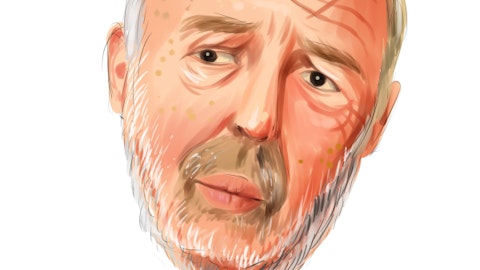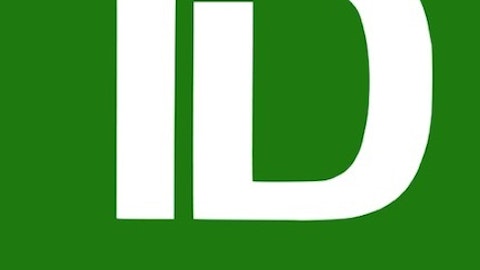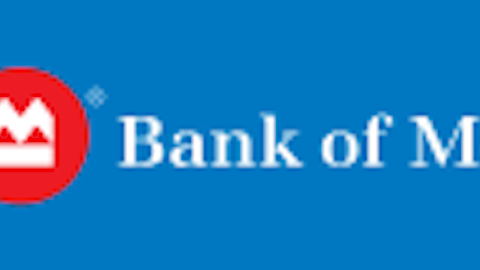
Royal Bank of Canada (USA) (NYSE:RY)
Thesis: With the worst of the financial crisis behind us, the global investment banking industry is poised for a rebound.
With $90 billion in market capitalization, Royal Bank of Canada (USA) (NYSE:RY) is the nation’s biggest and most diversified financial institution. RBC has its hands in every pot with the broadest geographical exposure and business lines. The company has operations in banking, wealth management, insurance and trading.
RBC’s investment banking business is the 12th largest internationally. Global M&A activity has been weak due to the fallout from the financial crisis but now there’s a lot of pent up demand from companies to issue debt, spin-off assets, merge, or go-private. RBC is the best play on the M&A rebound with investment banking accounting for 23% of the company’s income in 2012.
The Bank of Nova Scotia (NYSE:BNS)
Thesis: The emerging economies of Asia and Latin America are poised to deliver double-digit growth over the next decade.
The Bank of Nova Scotia (NYSE:BNS) is the most exotic of the Big-5 Canadian banks giving investors exposure to fast growing emerging economies like China, India, and Brazil. The company’s international operations posted 18% earnings growth in 2012 and accounted for 50% of the company’s profits.
BNS’s acquisition strategy has been to diversify its bets among several countries with small investments. Then the company waits patiently for the opportunity to make a major acquisition.
This tactic is risky. Almost a decade years ago, BNS took large losses when the Argentina government unexpectedly nationalized foreign banking assets. Yet the company’s investments in Peru and Columbia have paid off handsomely.
Canadian Imperial Bank of Commerce (NYSE:CM)
Thesis: Canada is well positioned due to the country’s resource boom and sound financial system.
The Canadian Imperial Bank of Commerce (NYSE:CM) is the smallest of the Big-5 by deposits. The company’s operations are primarily domestic making CIBC the closest thing to a pure play on Canadian retail banking.
CIBC was hit hard during the financial crisis when the company lost billions on sour U.S. mortgage bets. Since then the company has shored up its balance sheet and operations. CIBC has the highest Tier 1 capital ratio in the space and was rated the strongest bank North American by Bloomberg Markets Magazine.
Toronto-Dominion Bank (USA) (NYSE:TD)
Thesis: The American recovery is gaining momentum driven by the rebound in real estate and auto sales.
The Toronto-Dominion Bank (USA) (NYSE:TD) has undertaken a remarkably successful American expansion campaign. The company made a series of big acquisitions including Banknorth in 2004, Commerce Bancor in 2007, and Chrysler Financial in 2011. With more than 1,300 locations along the eastern seaboard, TD has the 11th largest branch network in the United States.
TD has been successful at picking up market share by increasing lending while competitors cut back during the financial crisis. With a quarter of profits derived from United States, the company is a great play on the American economic recovery, especially the boom in housing and automotive sales.
Bank of Montreal
Thesis: I want a well run bank with a big, fat, juicy yield.
The Bank of Montreal (NYSE:BMO) is an attractive investment for yield starved savers with the stock offering the highest yield in the space at just under 4.7%. BMO pays out 45% of its earnings to shareholders and the company has grown its dividend 9% annually over the past 10 years.
BMO is the slowest growing company in the space with investors trading future growth for current yield.
The company’s operations are split 70/30 between Canadian and U.S. retail banking. In 2011, BMO doubled down on its American expansion with the acquisition of Marshall & Ilsley for $4.1 billion. BMO is still building its U.S. operations investing heavily in marketing, refurbishing branches, and upgrading ATM machines, so it’s unclear how successful this expansion effort will be.
Foolish bottom line
The Big-5 are popular in the CAPS community with every name sporting a four or five star rating. Canadian banks make a great addition to any portfolio due to their safety and stability.
The article The Investor’s Guide to Picking Canadian Bank Stocks originally appeared on Fool.com and is written by Robert Baillieul.
Copyright © 1995 – 2013 The Motley Fool, LLC. All rights reserved. The Motley Fool has a disclosure policy.


